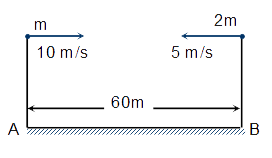Two object A and B are moving along the same straight line in opposite directions with velocities and respectively. They collide during which they stick to each other. If mass of A is and mass of B is , what is the velocity of the combinations?
Here,
According to the principle of conservation of linear momentum,
As v is +, therefore, the combination moves in the direction of object A.
Topper's Solved these Questions
- FORCES AND LAWS OF MOTIONBOOK - PRADEEPCHAPTER - FORCES AND LAWS OF MOTIONEXERCISE - ASSESSSMENT THROUGH PAPER-PEN TEST
29 Videos
- FORCES AND LAWS OF MOTIONBOOK - PRADEEPCHAPTER - FORCES AND LAWS OF MOTIONEXERCISE - MULTIPLE CHOICE QUESTIONS
28 Videos
- FORCES AND LAWS OF MOTIONBOOK - PRADEEPCHAPTER - FORCES AND LAWS OF MOTIONEXERCISE - QUIZ TESTING
12 Videos
- FLOTATIONBOOK - PRADEEPCHAPTER - FLOTATIONEXERCISE - Problem For Practice
6 Videos
- GRAVITATIONBOOK - PRADEEPCHAPTER - GRAVITATIONEXERCISE - Model Test paper (1)
36 Videos
Similar Questions
Two objects of masses 100g and 200g are moving along the same line in the same line in the same direction with velocities of 2m/s and 1m/s, respectively. They collide and after the collison, the first object moves at a velocity of 1.67m/s in the same direction. Determine the velocity of the second object.
View SolutionA railway carriage of mass 10gand200g are moving along the same line in the same direction with velocities of 2m/sand1m/s respectively. They collide and after the collison, the first object moves with a velocity of 1.67m/s in the same direction. Determine the velocity of the second object.
View Solution
Knowledge Check
Two equal masses m1 and m2 moving along the same straight line with velocites +3m/s and −5m/s respectively collide elastically. Their velocities after the collision will be respectively.
A+4m/s for bothB−3m/sand+5m/sC−4m/sand+4m/sD−5m/sand+3m/sTwo particles, one of mass m and the other of mass 2m, are projected horizontally towards each other from the same level above the ground with velocities 10 m/s and 5 m/s, respectively. They collide in air and stick to each other. The distance of the combined mass from point A is
 A40 mB20 mC30 mDzero
A40 mB20 mC30 mDzeroTwo particles A and B of masses 10 kg and 38 kg, respectively, are moving along the same straight line with velocities 15 m/s and 3 m/s, respectively, in the same direction. After elastic collision, the velocities of A and B are vAand vB, respectively, in the direction of initial motion. Then
 AvA=20m/s,vB=8msBvA=–4m/s,vB=8m/sCvA=16ms,vB=28m/sDvA=–5m/s,vB=10m/s
AvA=20m/s,vB=8msBvA=–4m/s,vB=8m/sCvA=16ms,vB=28m/sDvA=–5m/s,vB=10m/s
Two object, each of mass 1.5kg, are moving in the same straight line but in opposite directions, The velocity of each object is 2.5ms−1 before the collision during which they stick together. What will be the velocity of the combined object after collision?
View SolutionTwo object, each of mass 1.5kg, are moving in the same straight line but in opposite directions, The velocity of each object is 2.5ms−1 before the collision during which they stick together. What will be the velocity of the combined object after collision?
View SolutionTwo objects each of mass 5 kg are moving in the same straight line but in the opposite direction towards each other with some speed of 3 m/s. They stick to each other after collision. What will be the velocity of the combined object after collision?

View SolutionTwo objects each of mass 5 kg are moving in the same straight line but in the opposite direction towards each other with some speed of 3 m/s. They stick to each other after collision. What will be the velocity of the combined object after collision?

View SolutionTwo spheres made of clay of masses 'm1' and 'm2' moving along a straight line in the same direction collide with each other. Their velocities just before collision are 'u1' and 'u2' respectively. After collision, they stick together and move with teh same velocity, in the same direction, along the straight line. Find the velocity with which they move together.
View Solution
